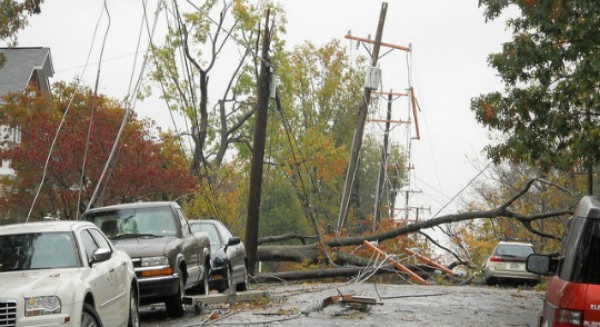Hurricanes, sometimes referred to as tropical cyclones, are forceful storm systems that affect vast ranges of land and can destroy entire communities. They happen fairly often and may last from a few days to a few weeks. They produce violent, swirling winds of 74 mph or higher, making them increasingly turbulent. They form over warm ocean waters as a collection of storms in the tropics, rotating counterclockwise in the Northern hemisphere and clockwise in the Southern hemisphere.
As hurricane winds blow against the vertical surface of a structure, such as a wall or steeply pitched roof, it exerts great pressure against the surface. As the wind flows over or around the home, it exerts “suction” on the walls or roof. The combination of these pressure and suction forces can cause uplift (stripping roof coverings and sheathing or, in extreme cases, destroying the entire roof), sliding (blowing a property straight off its foundation), overturning (the entire structure may rotate off its foundation resulting in the complete destruction of a home), and/or racking (causing walls to tilt and/or collapse).
In order for this occurrence to reach the status of a “hurricane”, it must first pass through two intermittent stages known as tropical depression and tropical storm. Hurricanes are the product of a successive increase in power and severity, leading to the categorical wind scale that determines how forceful it may be. Known as the Saffir-Simpson Hurricane Scale, the system outlines hurricanes’ levels as the following:
Category 1: Winds of 74-95 mph; minimal damage; most threatening to unanchored mobile homes, trees, and shrubbery.
Category 2: Winds of 96-110 mph; some possible damage to roofs, doors, and windows; plants, piers, and mobile homes, will be at increased risk for damage; low-lying areas are susceptible to flooding.
Category 3: Winds of 111-130 mph; small residences should expect a moderate amount of damage; mobile homes may be completely destroyed; coastal homes will be greatly affected by flooding.
Category 4: Winds of 131-151 mph; complete roof failure on smaller structures; beach erosion and volatile flooding.
Category 5: Winds of 155 mph or higher; complete roof failure on most buildings; some structures may collapse indefinitely; major destruction to coastal homes; possible mandatory evacuations.
Why Hurricane Categories Make a Difference
Basic Preparedness Tips
- Know where to go. If you are ordered to evacuate, know the local hurricane evacuation route(s) to take and have a plan for where you can stay. Contact your local emergency management agency for more information.
- Put together a disaster supply kit, including a flashlight, batteries, cash, first aid supplies, and copies of your critical information if you need to evacuate
- If you are not in an area that is advised to evacuate and you decide to stay in your home, plan for adequate supplies in case you lose power and water for several days and you are not able to leave due to flooding or blocked roads.
- Make a family emergency communication plan.
- Many communities have text or email alerting systems for emergency notifications.To find out what alerts are available in your area, search the Internet with your town, city, or county name and the word “alerts.”
Preparing Your Home
- Hurricane winds can cause trees and branches to fall, so before hurricane season trim or remove damaged trees and limbs to keep you and your property safe.
- Secure loose rain gutters and downspouts and clear any clogged areas or debris to prevent water damage to your property.
- Reduce property damage by retrofitting to secure and reinforce the roof, windows and doors, including the garage doors.
- Purchase a portable generator or install a generator for use during power outages. Remember to keep generators and other alternate power/heat sources outside, at least 20 feet away from windows and doors and protected from moisture; and NEVER try to power the house wiring by plugging a generator into a wall outlet.
- Consider building a FEMA safe room or ICC 500 storm shelter designed for protection from high-winds and in locations above flooding levels.
When the Waves Swell
Hurricane Watch
Hurricane watch = conditions possible within the next 48 hrs.
Steps to take:
- Review your evacuation route(s) & listen to local officials.
- Review the items in your disaster supply kit; and add items to meet the household needs for children, parents, individuals with disabilities or other access and functional needs or pets.
Hurricane Warning
Hurricane warning = conditions are expected within 36 hrs.
Steps to take:
- Follow evacuation orders from local officials, if given.
- Check-in with family and friends by texting or using social media.
- Follow the hurricane timeline preparedness checklist, depending on when the storm is anticipated to hit and the impact that is projected for your location.
What to do when a hurricane is 6 hours from arriving
- If you’re not in an area that is recommended for evacuation, plan to stay at home or where you are and let friends and family know where you are.
- Close storm shutters, and stay away from windows. Flying glass from broken windows could injure you.
- Turn your refrigerator or freezer to the coldest setting and open only when necessary. If you lose power, food will last longer. Keep a thermometer in the refrigerator to be able to check the food temperature when the power is restored.
- Turn on your TV/radio, or check your city/county website every 30 minutes in order to get the latest weather updates and emergency instructions.
What to do when a hurricane is 6-18 hours from arriving
- Turn on your TV/radio, or check your city/county website every 30 minutes in order to get the latest weather updates and emergency instructions.
- Charge your cell phone now so you will have a full battery in case you lose power.
What to do when a hurricane is 18-36 hours from arriving
- Bookmark your city or county website for quick access to storm updates and emergency instructions.
- Bring loose, lightweight objects inside that could become projectiles in high winds (e.g., patio furniture, garbage cans); anchor objects that would be unsafe to bring inside (e.g., propane tanks); and trim or remove trees close enough to fall on the building.
- Cover all of your home’s windows. Permanent storm shutters offer the best protection for windows. A second option is to board up windows with 5/8” exterior grade or marine plywood, cut to fit and ready to install.
What to do when a hurricane is 36 hours from arriving
- Turn on your TV or radio in order to get the latest weather updates and emergency instructions.
- Build or restock your emergency preparedness kit. Include a flashlight, batteries, cash, and first aid supplies.
- Plan how to communicate with family members if you lose power. For example, you can call, text, email or use social media. Remember that during disasters, sending text messages is usually reliable and faster than making phone calls because phone lines are often overloaded.
- Review your evacuation plan with your family. You may have to leave quickly so plan ahead.
- Keep your car in good working condition, and keep the gas tank full; stock your vehicle with emergency supplies and a change of clothes.
After a Hurricane
- Listen to local officials for updates and instructions.
- Check-in with family and friends by texting or using social media.
- Return home only when authorities indicate it is safe.
- Watch out for debris and downed power lines.
- Avoid walking or driving through flood waters. Just 6 inches of moving water can knock you down, and fast-moving water can sweep your vehicle away.
- Avoid flood water as it may be electrically charged from underground or downed power lines and may hide dangerous debris or places where the ground is washed away.
- Photograph the damage to your property in order to assist in filing an insurance claim.
- Do what you can to prevent further damage to your property, (e.g., putting a tarp on a damaged roof), as insurance may not cover additional damage that occurs after the storm.
When there is no hurricane: Make a hurricane plan
- Know your hurricane risk. Talk to your local emergency management agency.
- Make an emergency plan.
- Build or restock your basic disaster supplies kit, including food and water, a flashlight, batteries, chargers, cash, and first aid supplies.
- Consider buying flood insurance.
- Familiarize yourself with local emergency plans. Know where to go and how to get there should you need to get to higher ground or to evacuate.
- Stay tuned to local wireless emergency alerts, TV, or radio for weather updates, emergency instructions, or evacuation orders.


 From Ready.gov
From Ready.gov




